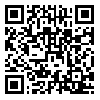Volume 6, Issue 4 (Oct-Dec 2017)
JCHR 2017, 6(4): 207-215 |
Back to browse issues page
Download citation:
BibTeX | RIS | EndNote | Medlars | ProCite | Reference Manager | RefWorks
Send citation to:



BibTeX | RIS | EndNote | Medlars | ProCite | Reference Manager | RefWorks
Send citation to:
Pourshams M, JanFada H. Investigation of the Effects of Religious Beliefs on Compliance with Traffic Laws and Regulations on Yazd Province Drivers (Structural Equation Modeling Approach)
. JCHR 2017; 6 (4) :207-215
URL: http://jhr.ssu.ac.ir/article-1-405-en.html
URL: http://jhr.ssu.ac.ir/article-1-405-en.html
1- Deputy of Technical Traffic, Management and Command Office, Yazd, Iran , mohammad.purshams@gmail.com
2- Disaster Risk Reduction Office, Deputy of Health, Shahid Sadoughi University of Medical Sciences, Yazd, Iran
2- Disaster Risk Reduction Office, Deputy of Health, Shahid Sadoughi University of Medical Sciences, Yazd, Iran
Abstract: (5352 Views)
Abstract
Introduction: It is obvious that driving without laws and regulations is a threat to every society's order and safety ultimately leading to accidents and loss of life. Several factors play a role in observance of traffic laws and regulations. The main purpose of this research was to investigate the effect of religious beliefs on compliance with traffic laws and regulations that could lead to improvement of order, safety and reduction of casualties and accidents in Yazd City.
Methods: This was a descriptive study which conducted in 2017 in 384 citizens of Yazd province aged over 18 years with a driver's license and ownership of a car or motorcycle which randomly selected.. The data collection tool were two questionnaires, (Golak and Stark religiosity)and a questionnaire complying with the traffic rules and regulations. Data analysis was performed by Structural Equation Modeling (, partial least squares and Pls software to test the assumptions and accuracy of the model.
Results: The findings showed that the effect of the lateral dimension of religious beliefs on compliance with traffic rules and regulations among drivers in Yazd was0.518, the effect of the emotional dimension of religious beliefs on compliance with the rules and regulations among the drivers was 0.270 and the effect of the religious beliefs on the observance of the rules and regulations among the drivers of Yazd was 0.05. There was thus a significant relationship between the variables of religious beliefs and the observance of traffic laws and regulations (adherence to the rules influenced by Religious Beliefs).
Conclusion: In general, the results of this research showed that religious beliefs included in this research can increase the observance of traffic rules and regulations and with its continuation over time result in reduction of accidents and consequent losses.
Keywords: Driving Directions, Religious Beliefs, Yazd
Introduction: It is obvious that driving without laws and regulations is a threat to every society's order and safety ultimately leading to accidents and loss of life. Several factors play a role in observance of traffic laws and regulations. The main purpose of this research was to investigate the effect of religious beliefs on compliance with traffic laws and regulations that could lead to improvement of order, safety and reduction of casualties and accidents in Yazd City.
Methods: This was a descriptive study which conducted in 2017 in 384 citizens of Yazd province aged over 18 years with a driver's license and ownership of a car or motorcycle which randomly selected.. The data collection tool were two questionnaires, (Golak and Stark religiosity)and a questionnaire complying with the traffic rules and regulations. Data analysis was performed by Structural Equation Modeling (, partial least squares and Pls software to test the assumptions and accuracy of the model.
Results: The findings showed that the effect of the lateral dimension of religious beliefs on compliance with traffic rules and regulations among drivers in Yazd was0.518, the effect of the emotional dimension of religious beliefs on compliance with the rules and regulations among the drivers was 0.270 and the effect of the religious beliefs on the observance of the rules and regulations among the drivers of Yazd was 0.05. There was thus a significant relationship between the variables of religious beliefs and the observance of traffic laws and regulations (adherence to the rules influenced by Religious Beliefs).
Conclusion: In general, the results of this research showed that religious beliefs included in this research can increase the observance of traffic rules and regulations and with its continuation over time result in reduction of accidents and consequent losses.
Keywords: Driving Directions, Religious Beliefs, Yazd
Review: Research |
Subject:
General
Received: 2017/12/9 | Accepted: 2017/12/9 | Published: 2017/12/9
Received: 2017/12/9 | Accepted: 2017/12/9 | Published: 2017/12/9
Send email to the article author
| Rights and permissions | |
 |
This work is licensed under a Creative Commons Attribution 4.0 International License. |





